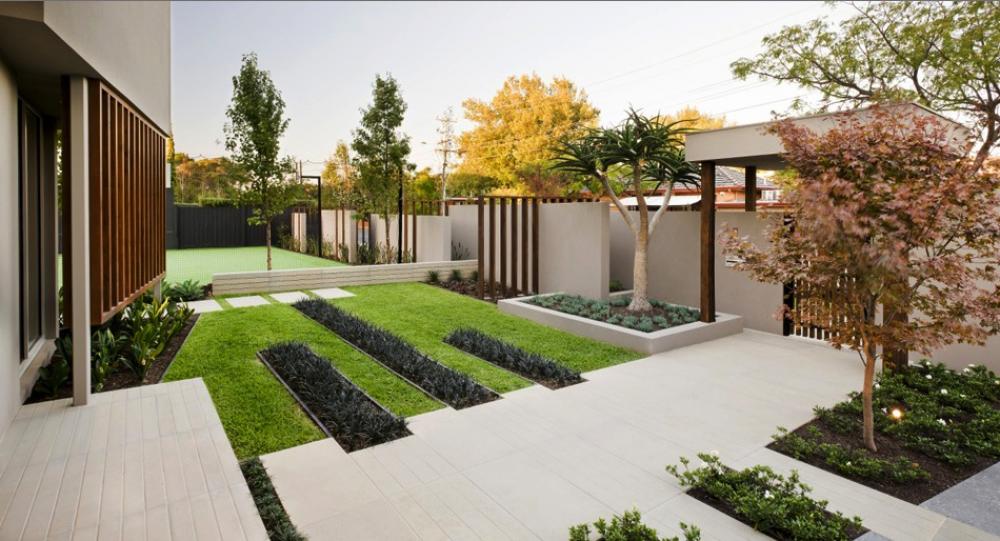In this article, we will explore the benefits and principles of minimalist home landscaping, provide tips and ideas for creating a stunning minimalist landscape, and answer some frequently asked questions about this design style.

Benefits of Minimalist Home Landscaping
There are many benefits to adopting a minimalist approach to home landscaping. Some of the most significant advantages include:
- Low Maintenance: Minimalist landscapes typically require less upkeep and maintenance than more elaborate designs. With fewer plants, trees, and decorative elements, there is less to water, prune, and mow.
- Cost-Effective: Minimalist landscapes are often less expensive to install and maintain than more complex designs. With a focus on natural materials and simple design elements, the cost of implementation can be significantly reduced.
- Sustainable: Minimalist landscapes often incorporate sustainable design principles, such as rainwater harvesting, native plants, and energy-efficient outdoor lighting.
- Visual Clarity: Minimalist landscapes provide a clean and uncluttered visual aesthetic, creating a sense of calm and serenity in the outdoor space.
Principles of Minimalist Home Landscaping
To create a beautiful and effective minimalist landscape, there are several key principles to keep in mind:
- Simple Color Palette: A limited color palette is essential to minimalist design. Choose a few key colors and stick to them to create a cohesive and calming visual aesthetic.
- Natural Materials: Incorporate natural materials, such as wood, stone, and plants, to create a sense of connection to the natural world.
- Clean Lines: Use clean lines and simple shapes to create a sense of visual clarity and order in the landscape.
- Limited Ornamentation: Avoid excessive ornamentation and decoration, instead focusing on simple, functional design elements.
Tips and Ideas for Creating a Minimalist Landscape
Here are some tips and ideas for creating a stunning minimalist landscape:
- Use Native Plants: Incorporate native plants and trees to create a sense of connection to the local environment and reduce maintenance requirements.
- Incorporate Negative Space: Don’t be afraid to use negative space in your landscape design. Empty spaces can create a sense of calm and serenity, and draw attention to key design elements.
- Choose Simple Hardscaping: Use simple, natural hardscaping materials, such as wood, stone, or concrete, to create clean lines and functional spaces.
- Incorporate Water Features: A simple water feature, such as a small fountain or pond, can add visual interest and create a sense of calm in the landscape.
Frequently Asked Questions
Here are some frequently asked questions about minimalist home landscaping:
- Q: Is minimalist landscaping only for modern homes?
A: No, minimalist landscaping can be adapted to any style of home or architecture. The key is to focus on simple, clean design elements that complement the natural beauty of the surrounding environment. - Q: How do I incorporate color into a minimalist landscape?
A: Choose a few key colors and stick to them to create a cohesive and calming visual aesthetic. Consider using natural materials, such as wood or stone, to add warmth and texture to the landscape. - Q: Can I still have a garden in a minimalist landscape?
A: Yes, you can still have a garden in a minimalist landscape. Consider using a simple, raised bed design and incorporating native plants or a few key species to create a sense of connection to the natural world. - Q: How do I maintain a minimalist landscape?
A: Minimalist landscapes are designed to be low-maintenance. Focus on simple, functional design elements and incorporate natural materials to reduce upkeep and maintenance requirements.
Conclusion
Minimalist home landscaping is a beautiful and effective way to create a sense of calm and serenity in the outdoor space. By emphasizing simplicity, clean lines, and a limited color palette, homeowners can create a stunning landscape that complements the natural beauty of the surrounding environment. Whether you’re looking to reduce maintenance requirements, create a sustainable landscape, or simply create a sense of visual clarity, minimalist home landscaping is definitely worth considering. With its focus on natural materials, simple design elements, and negative space, minimalist landscaping is a design style that can be adapted to any home or architecture, and is sure to provide years of beauty and enjoyment.
Closure
Thus, we hope this article has provided valuable insights into Minimalist home landscaping. We appreciate your attention to our article. See you in our next article!